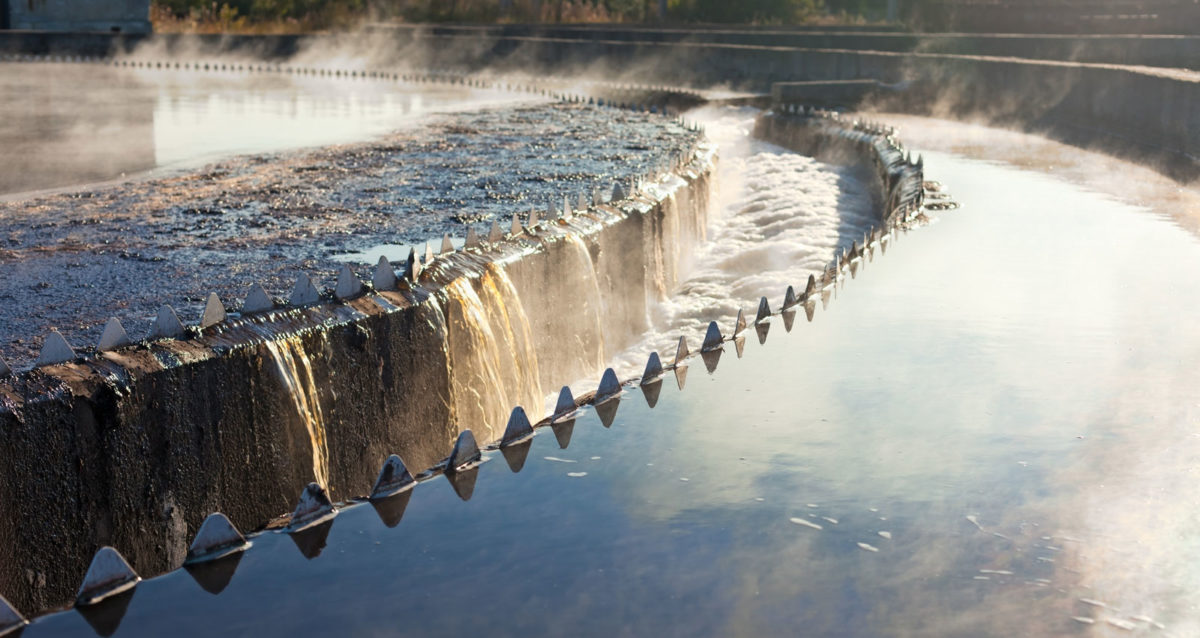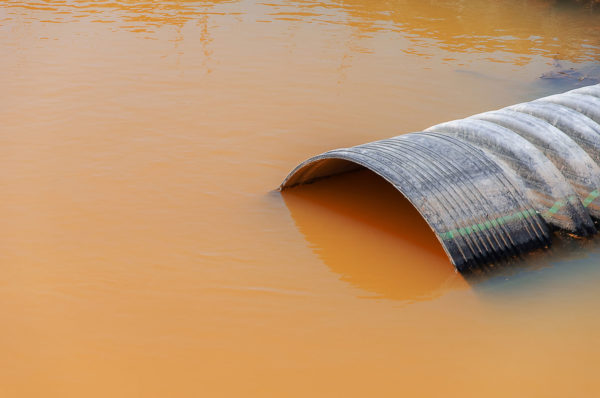CELDF has assisted the first communities in the U.S. to prohibit sewage sludge, a dangerous solid waste product that is spread on farm fields. Below learn about the perils of sewage sludge, how communities are organizing to stop them, and what you can do in your community.
Communities across the country are facing the many problems associated with corporate control of agriculture. The corporatization of agriculture means that fewer and fewer people (acting through corporations) are controlling more and more of our food production. One of the symptoms of this corporate takeover is the land application of sewage sludge on croplands. Sewage sludge is the solid waste remaining after wastewater from homes, factories, hospitals, industrial sites – anywhere that has a drain – is flushed away and goes through a sewage treatment plant.
But this solid waste doesn’t really go “away.” It is collected at wastewater treatment plants after it’s removed from the water, so that the water can be returned to the aquifers, streams and rivers with a lot less poison and pollutants in it. What’s left behind is sewage sludge.
Why does it matter?
Millions of tons of toxic, even radioactive[1] sewage sludge have been dumped on America’s school yards, parks and farmland since the Environmental Protection Agency (EPA) began this “land application” of sewage sludge under the 1993 Clean Water Act.[2]
This practice of so-called “recycling bio-solids” exists as a cheap way for government and corporations to get rid of sewage sludge – cheaper than burying it in landfills or incinerating it.[3] However, by supplying farmers with this hazardous material as fertilizer to grow our food, the sludge is sent back into the environment, our food and our bodies.

“Treated”
Plants that handle waste water are designed specifically to reduce pollutants such as suspended solids, pH, oil and grease, and fecal coliform bacteria. What it doesn’t do, however, is remove metals and organic chemicals. Treatment plants can’t address the tens of thousands of chemicals entering the plant each day, and worse, more are created during the treatment process, such as carcinogenic “disinfection byproducts” like Trihalomethanes (THMs) and N nitrosodimethylamine (NDMA).[12]
Before being dumped on land, the sludge must also be treated to limit concentrations of nine heavy metals and one “indicator” pathogen (fecal coliform),[4] which leaves the roughly 93,000 other chemicals[5] in the stream of commerce to remain in the toxic fertilizer.
Sewage sludge is complex and results in mystery toxins due to the hazardous combination of thousands of chemicals. Whatever can make it down a drain winds up in sewage sludge. Hazardous materials found in sewage sludge include heavy metals (lead, mercury and others)[3], pathogens, synthetic chemicals, hydrocarbons, petrochemicals, organochlorines, pharmaceuticals, intestinal worms, fungus, steroids and hormones.[6][7]
Numerous health issues have been linked to exposure to sewage sludge. These hazards include:
- Cancer[3]
- Respiratory infections[8]
- Aggravated asthma[8]
- Pneumonia[8]
- Staph infections[8]
- Lung scarring[9]
- E. coli infections[3]
- Salmonella poisoning[3]
- Hives and other rashes[8]
- Headaches[8]
- Burning eyes[9]
- Nausea[8]
- Death[9][10]
Ultimately, about 8 million tons of biosolids, or treated sewage sludge, is disposed of each year in the U.S., 55% of which is spread on the land.[13]
Something in the water
The amount of toxic water discharged from publicly owned water treatment plants – where sewage sludge is collected and lightly treated – is astonishing. The Carpinteria Wastewater Treatment Plant in California provides an example. Complete with a state-of-the-art secondary treatment system, this plant annually discharges over half a billion gallons of contaminated wastewater off Rincon Point, a popular surfing spot. A permit issued by the state of California allows the Carpinteria plant’s “treated” wastewater to contain:
- 10 tons of Arsenic
- 3 tons of Lead
- 113 pounds of Mercury
- 31,000 tons of Toluene
- 2 tons of Benzene
- 47 tons of Chloroform
- 12 tons of Vinyl Chloride
- And millions of tons of other hazardous chemicals[12]
This is the amount of pollutants sent into the Pacific Ocean on a yearly basis – from one plant. The Carpinteria wastewater treatment plant is relatively small, discharging two million gallons a day.[12] The Los Angeles County’s Joint Water Pollution Control Plant discharges 510 million gallons of pollutants a day.[12]
EPA researchers who have spoken out about the health and environmental risks of current practices regarding sewage sludge have been fired. And sludging is allowed to continue.
Corporate “right” to Cause harm
Synagro, the nation’s largest sludge corporation, has contracts with municipal authorities – worth more than $1 billion – to manage sewage sludge.[2] Communities have taken Synagro to court countless times. In 2009, farmers in Franklin County, Alabama filed a lawsuit against Synagro and other local industries after toxic sewage sludge poisoned their water supplies, cattle ponds and 5,000 acres of land.[11] One man from New Hampshire died of staphylococcus aureus infection one month after passing through land where Synagro had dumped sludge – his family reached an out-of-court settlement for an undisclosed amount of money and agreed to drop the lawsuit and sign a gag order.[9]

State and corporate legal authority
Much debate about regulating the use of sewage sludge is centered on a section of the Clean Water Act known as the 503 Sludge Rule. Local attempts to increase regulation or to ban the spreading of sewage sludge outright are routinely denied by coercive state laws, despite a clause (503.6) that states, “The determination of the manner in which sewage sludge is used or disposed is a local determination.”
While most of us were taught that the U.S. Constitution was written to protect the rights of human beings, residents who try to prevent a corporation from spreading sewage sludge are threatened with a lawsuit for violating the corporation’s “rights.”
Worse, residents confronting corporate sludgers learn that their state government – with the help and at the behest of corporations – has legally authorized sludging to take place. People discover that they face not only corporate directors who wield the constitutional “rights” of corporations, but that their own state issues permits to sludging corporations and preempts citizens from protecting their communities from toxic sludge.
CELDF in action
The Community Environmental Legal Defense Fund has been at the forefront of this issue, helping residents, local groups, and municipal officials to ban the land application of sewage sludge and to create the communities they envision. Over a decade ago, we began assisting communities threatened with sludging – working with them to draft ordinances that challenged state preemption and asserted the right of people to exercise local self-governance to protect their environment, health, safety, welfare and quality of life. Since 2012, more than 80 communities in Pennsylvania have banned corporations from engaging in the land application of sewage sludge.
Through CELDF-drafted Community Bills of Rights, nearly 200 communities have stood up to help establish Community Rights as superior to corporate rights, to promote local economies and sustainable energy, to protect people’s rights to clean air and drinking water, and to ensure the right of ecosystems to thrive.
Take action.
Stand up against the land application of sewage sludge.
If you or your community is threatened by the application of sewage sludge, contact CELDF and learn how to take action. You and your community have rights and CELDF is here to help you fight for them.
Sources
[1] http://sludgevictims.com/radioactive-sludge.html
[2] http://www.sludgenews.org/
[3] https://www.organicconsumers.org/old_articles/Toxic/sewadge_sludge.php
[4] http://sludgevictims.com/pdf_files/1.5-handout-sludge-contaminates.pdf
[5] http://sludgevictims.com/toxic_in_sludge.html
[6] http://sludgevictims.com/pdf_files/1.5-handout-sludge-contaminates.pdf
[7] http://www.rense.com/general27/risd.htm
[8] http://www.nidellaw.com/the-local-nose-knows-best-what-to-do-with-sewage-sludge/
[9] http://sludgevictims.com/pdf_files/SludgeSynagroLeafletSEIU.pdf
[10] http://www.rense.com/general27/risd.htm
[11] http://sewagesludgeactionnetwork.com/files/SYNAGRO_VIOLATIONS.pdf
[12] http://www.sludgenews.org/about/sludgenews.aspx?id=4
[13] Peccia, Jordan, and Paul Westerhoff. “We Should Expect More out of Our Sewage Sludge.” Environmental Science & Technology Environ. Sci. Technol. 49.14 (2015): 8271-276. http://pubs.acs.org/doi/full/10.1021/acs.est.5b01931
